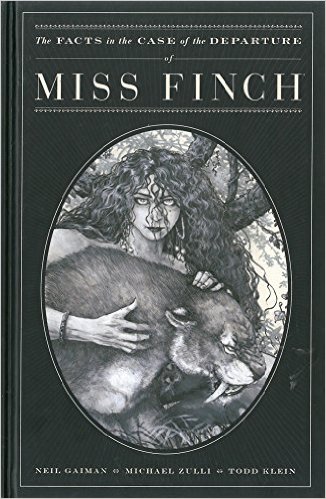 The Facts in the Case of the Departure of Miss Finch is an adaptation of a Neil Gaiman short story, first published in comic form in 2008. At the time of its release, I, sadly, had not yet discovered Mr. Gaiman. In the years since then, he has become one of my favorite authors in any medium. There is something terribly unique about Mr. Gaiman’s work; it’s as if his (prose) stories are meant to be read out loud, lending them a style and tone that is all together his own.
The Facts in the Case of the Departure of Miss Finch is an adaptation of a Neil Gaiman short story, first published in comic form in 2008. At the time of its release, I, sadly, had not yet discovered Mr. Gaiman. In the years since then, he has become one of my favorite authors in any medium. There is something terribly unique about Mr. Gaiman’s work; it’s as if his (prose) stories are meant to be read out loud, lending them a style and tone that is all together his own.
Even if you have never heard of Neil Gaiman, there is a good chance you’ve heard of his work. Whether it is stop-animation classic, Coraline, the incredibly esteemed Sandman graphic novel series, the Robert DeNiro featuring fairy tale film, Stardust, or radio play/BBC TV series, Neverwhere, Gaiman is a superstar in the literary world.
Much of this is because his stories, separate from their tone and voice, interweave genres with an ease that is all together remarkable. Neil Gaiman’s stories weave together classic or all-but-forgotten folklore, magic, mystery, horror, romance, and fantasy. His characters are universally well developed and interesting, coming to life with each passing page. What’s more remarkable, however, is that Gaiman avoids steeping himself in horrors and shock value; he does not wade into needless violence, sex, gore (though doesn’t shy away from adult themes if it serves the story). Across the board, Neil Gaiman’s work is rooted in amazing ideas and rich storytelling that hews much closer to the adult fairy tale.
Such is the case with the Departure of Miss Finch. The story was originally published in the UK version of his 1998 short story collection, Smoke and Mirrors. Partnering with artist Michael Zulli, Neil has adapted the story to graphic novel form, and it works exceedingly well.
The novel is short, hovering right around fifty pages, so to say to much would be to spoil the tale. In a nutshell, however, three friends gather in London and are joined by the rigid Miss Finch. Together, they go out for an evening of entertainment and find themselves exploring a subterranean circus of haunting displays. What first appears to be shtick soon proves to be something more, and so the mystery unfolds.
The narrator never tells us his name, but I was struck at the visual similarity to Mr. Gaiman himself. As I read, I couldn’t help but interject his voice into my head. More broadly speaking, Mr. Zulli’s art is rich and refined, but also sketch-like and impressionistic. It is thematically dark, but also evocative, and works wonderfully to sell the skepticism being shared by the party of circus-goers.
The storyline is quintessential Gaiman. What seems normal on the surface – an author’s getaway to focus on his work – quickly turns into something else entirely. Like much of his work, Miss Finch relishes the idea that there is more to our world just brimming under the surface. We experience this alongside our narrator, sharing in his bewilderment. Yet, at the same time, we are given a peak of the ending before the tale even begins, so even more than he, we know that there is more to the macabre circus than first meets the eye.
It should be clear at this point that I very much enjoyed The Facts in the Case of the Departure of Miss Finch and would recommend it to anyone who is even passingly interested at what I’ve described here. It is a good introduction into the themes Neil Gaiman weaves throughout his work, and a short read that can easily be finished on a day’s commute. Fair warning, though, that there is a touch of nudity, so I wouldn’t open the e-version at work.
Happy reading!





1 ping